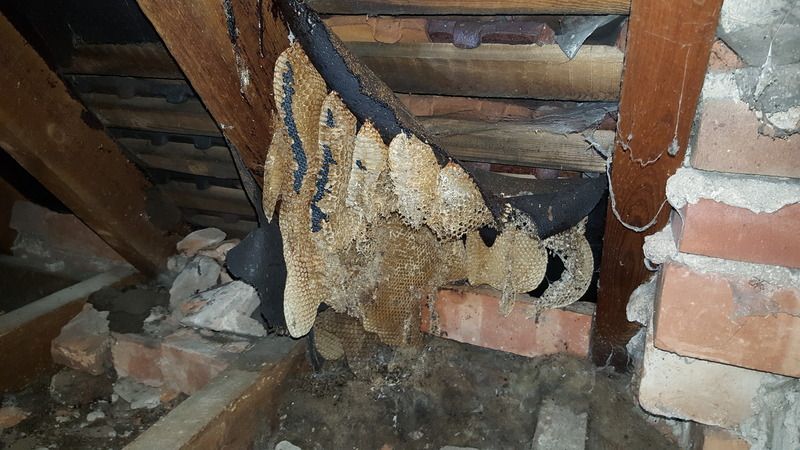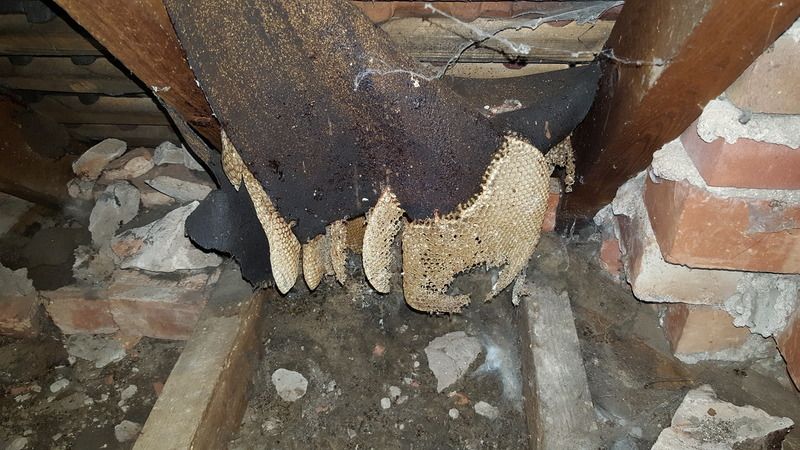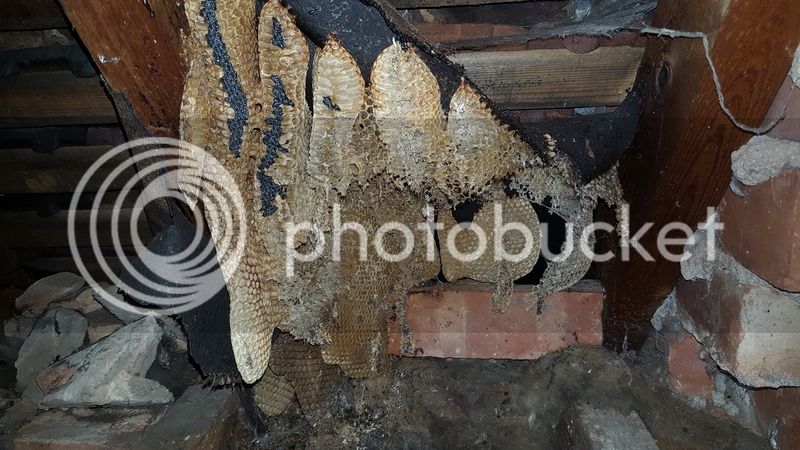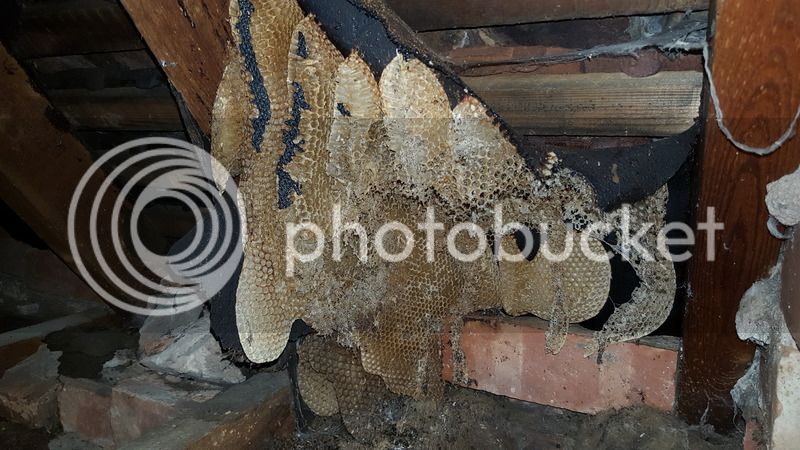You are using an out of date browser. It may not display this or other websites correctly.
You should upgrade or use an alternative browser.
You should upgrade or use an alternative browser.
Bee's in Chimney
- Thread starter nantmoel
- Start date

Help Support Beekeeping & Apiculture Forum:
This site may earn a commission from merchant affiliate
links, including eBay, Amazon, and others.
GoEnviro
New Bee
- Joined
- Jun 10, 2010
- Messages
- 41
- Reaction score
- 5
- Location
- Lyme Regis & Cardiff, UK
- Hive Type
- National
- Number of Hives
- 10
For information; taken from BBKA Insurance FAQs -
5. I am called by a member of the public to collect bees that have swarmed – am I covered? What happens if I charge for my services?
You are covered provided it is part of your normal beekeeping activities. If you charge reasonable expenses then this will not affect your cover. However, if you make a business out of swarm collection this would be viewed differently. You would need normal Commercial Insurance for this business activity which is not covered by the BBKA policy.
Please refer to the Swarm Collection guidance on the BBKA website.
6. Is there any restriction on working at height?
Previously the policy included a working limit of 3 metres (applying to the beekeeper, not the swarm). This is no longer the case, replaced instead by the need to consult BBKA guidelines on swarm collection and height, which are available on the website.
Broadly speaking, you should not attempt any work for which you do not have adequate equipment, training or experience. The policy does not cover reckless acts, so if you are in doubt seek guidance from someone with the relevant experience or training, or preferably use an alternate method that would avoid you having to climb to height.
BBKA now provides a Swarm Collection Disclaimer. Not sure how effective it would be in practice if a lot of damage was caused or the damage was beyond the property owners expectations.
Interesting - had not even considered that the BBKA insurance would cover swarm collection activities.
Anybody know at what point a swarm is considered a colony?
I have no problem with people going out collecting swarms - i can't image beekeepers not doing so. BUT it may be wise if they actually gathered information about the circumstances of the swarm so that they could assess the viability of the collection of it - we regularly attend properties that have had a beekeeper or two out who have not been able to do anything as it is beyond their comfort zone. Unfortunately this has an expensive knock on for a property owner because most swarms can be moved on within first 24 hours easily, but as time passes costs for their eviction rise
It would be far better if they were straight up and told the homeowner that they really needed to bring in a pest controller ASAP, and that yes swarmcatching is free when swarms are easy but cost when in a property.
Would be an idea if BBKA kept a register of pest control companies that have a clue about what they are doing as well.
I can think of some large national companies that happily dust the outside of properties and the rest of the neighbourhood without sealing up post treatment.
I have also seen local beekeepers dust colonies in churches and not seal up - with the subsequent run of honey down the walls. I'm guessing they don't keep bees locally.
A lot of pest control companies also dust Tree Bumblebee colonies, not so clever as I understand they visit the same flowers as honeybees.
GoEnviro
New Bee
- Joined
- Jun 10, 2010
- Messages
- 41
- Reaction score
- 5
- Location
- Lyme Regis & Cardiff, UK
- Hive Type
- National
- Number of Hives
- 10
Martin i'm truly impressed - you put me to shame, wish it were half as easy for me
abm
House Bee
- Joined
- Sep 6, 2013
- Messages
- 226
- Reaction score
- 17
- Location
- Mansfield
- Hive Type
- National
- Number of Hives
- 7
How much plopped down the flue? Did you retrieve it and how?
What was the Mask you sprayed on?
What do you do when the comb continues down 8ft?
Morning bud,
The vid only showed a third of hands on, and.... the main comb with HRH plopped directly down out of sight, and un retrieved as the stack was completely closed off downstairs.
The mask was ABM mix.
The footage didn't show clearly some of the longer brace comb removed so It was left out, but 2 sections were almost 3ft, and when its too far to reach then the remaining is treated and sealed.
Like any job, having the best tools at hand makes life easier, the task from start to finish - scaffold up to scaffold down took just over 3.5hrs.

£13.16 (£42.59 / kg)
Blmirror Plastic Beekeeping Honey Tap Gate Valve Beekeeping Extractor Bottling Honey Gate Honey Extractor Equipment Tool
Hongfushangdian

£2.69
Bee Tools Duckbill Feeder Hive Door Beekeeping Water Dispenser Multifunctional Sugar Entry Feeder Cap for Beekeeper Equip Garden Hive Tool (5 Pcs)
Lizeaskon (7-10 days delivery!!!)

£169.99
Bee Hive British National Cedar Wood with Brood Box and Two Supers Beekeeping Complete Set Hives Beekeeper Equipment
Apiary Gear Supplies

£14.98
£25.00
The Bee Manual: The Complete Step-by-Step Guide to Keeping Bees (New Ed)
⭐ Lowplex Books® ⭐

£12.90 (£41.75 / kg)
Qyrugcxs Plastic Beekeeping Honey Tap Gate Valve Beekeeping Extractor Bottling Honey Gate Honey Extractor Equipment Tool
Ruimitudianzi

£15.48
Cut Comb Honey Containers Honey Cut with 10Pcs Plastic Box Stainless Steel Cut Comb Honey Containers Beautiful and Practical Beekeeping Tools for Cutting Nesting Honey, Putting Comb Honey
JianShiXianQingGeFanShangMaoYouXianGongSi

£15.29
£18.99
The Bee Book: The Wonder of Bees – How to Protect them – Beekeeping Know-how
Amazon.co.uk

£13.60 (£2.72 / count)
5pcs Bee Hive Entrance Entrance Gate Anti-Scape Door Beekeeping Tool Equipment
Herexty

£12.02 (£38.90 / kg)
GREOHNMPAW Plastic Beekeeping Honey Tap Gate Valve Beekeeping Extractor Bottling Honey Gate Honey Extractor Equipment Tool
yinsaihui
Gilberdyke John
Queen Bee
- Joined
- May 5, 2013
- Messages
- 5,782
- Reaction score
- 2,080
- Location
- HU15 East Yorkshire
- Hive Type
- 14x12
- Number of Hives
- 10
Morning bud,
The vid only showed a third of hands on, and.... the main comb with HRH plopped directly down out of sight, and un retrieved as the stack was completely closed off downstairs.
The mask was ABM mix.
The footage didn't show clearly some of the longer brace comb removed so It was left out, but 2 sections were almost 3ft, and when its too far to reach then the remaining is treated and sealed.
Like any job, having the best tools at hand makes life easier, the task from start to finish - scaffold up to scaffold down took just over 3.5hrs.
I sent a link of your YouTube video to my friend Adrian (now retired from AB pest control) his feedback was full of praise for you both as a friend and a professional. Your reputation precedes you
Last edited:
abm
House Bee
- Joined
- Sep 6, 2013
- Messages
- 226
- Reaction score
- 17
- Location
- Mansfield
- Hive Type
- National
- Number of Hives
- 7
I sent a link of your YouTube video to my friend Adrian (now retired from AB pest control) his feedback was full of praise for you both as a friend and a professional. Your reputation precedes you
Thanks John, Adrian is a great man too.
- Joined
- Apr 10, 2010
- Messages
- 11,444
- Reaction score
- 3,203
- Location
- Stoke on Trent
- Hive Type
- Langstroth
- Number of Hives
- 6 to 8 Langstroth jumbos, a few Langstroth and National nucs.
es that happily dust the outside of properties and the rest of the neighbourhood without sealing up post treatment.
I have also seen local beekeepers dust colonies in churches and not seal up - with the subsequent run of honey down the walls. I'm guessing they don't keep bees locally.
.
Report them..
"Pest controller fined £1,000 for offences resulting in the death of thousands of honey bees"
http://tinyurl.com/zgfkzfd
Itchy
Field Bee
- Joined
- Aug 28, 2013
- Messages
- 766
- Reaction score
- 1
- Location
- Surrey
- Hive Type
- National
- Number of Hives
- Lost count and can't keep up
We go to great lengths to avoid any drop of comb-any spillages would risk seepage into the fabric of the building and will encourage problems in the premises with the many insects that feast on comb, dead brood, pollen stores and honey.
If HRH isn't found and caged, we ensure eggs are about in the new hive to make a new one, but sometimes she just appears (like they do)
We don't use a mask spray at all - nothing lasts as long as the smell of a hive.
Insecticide will only be used post removal if there is a risk of bees creeping out of the fireplace and into the rooms, and would be a problem for the owner.
Chimneys are almost always very difficult unless you dismantle it, which, in most cases, isn't desirable.
Post re homing, the biggest risk to the colony is dysentery, probably due to the damaged and dead larvae that will inevitably result. Anyone have any remedies for this?
If HRH isn't found and caged, we ensure eggs are about in the new hive to make a new one, but sometimes she just appears (like they do)
We don't use a mask spray at all - nothing lasts as long as the smell of a hive.
Insecticide will only be used post removal if there is a risk of bees creeping out of the fireplace and into the rooms, and would be a problem for the owner.
Chimneys are almost always very difficult unless you dismantle it, which, in most cases, isn't desirable.
Post re homing, the biggest risk to the colony is dysentery, probably due to the damaged and dead larvae that will inevitably result. Anyone have any remedies for this?
Mr C
House Bee
Those look relatively easy and small. Try dealing with a huge colony 8ft down a flue!
I only do my best never know wot you have until you open then up
Swinton apiaries
House Bee
- Joined
- Jan 25, 2015
- Messages
- 116
- Reaction score
- 5
- Location
- Matlock
- Hive Type
- National
- Number of Hives
- 30
Good video but this is my piont round here Crich is the meeting place for Derbyshire bee keepers and non of them have wanted to do this and I'm presuming non of them contacted you to help or watch how it's done well done maby you should be runing Association
GoEnviro
New Bee
- Joined
- Jun 10, 2010
- Messages
- 41
- Reaction score
- 5
- Location
- Lyme Regis & Cardiff, UK
- Hive Type
- National
- Number of Hives
- 10
Report them..
"Pest controller fined £1,000 for offences resulting in the death of thousands of honey bees"
http://tinyurl.com/zgfkzfd
2008 is a longtime ago
GoEnviro
New Bee
- Joined
- Jun 10, 2010
- Messages
- 41
- Reaction score
- 5
- Location
- Lyme Regis & Cardiff, UK
- Hive Type
- National
- Number of Hives
- 10
I'll try and get a couple of pics of todays job up over the next day or two - worked on it from inside roof space - must have lost a few kilos myself it was that hot - no fun whatsoever.
Thermal camera showed hive running to just a couple of brick courses above floor, so took out brick to confirm - camera was right (worth the £600 investment by us - our customers can save on several hours messing about or the cost of expensive scaffolding as a result of the Flir C2)
Removed necessary bricks running down its height- lots of black dust to find a colony just shy of 1.5mts high in a gap approx 300x300mm.
Carried out cutout and vac, placing some brood with nurse bees in a poly nuc and rest of the bees and queen vacuumed into a brood box with frames etc already in place. Cleaned down all remaining wax and left brood box to pick up stragglers and assist (with any luck) in the honey cleanup.
Also took a pic to try and get some comb spacing dimensions; interestingly some of the comb for storing honey can be quite thick and bee space quite small.
There were signs of previous pest control attempts with bombs placed close by and dropped into the cavity.
Which brings to attention the actions of another fairly local pest controller who according to an upset caller went to a feral honey bee colony in a chimney lined with a gas flue; despite the fact ithe honey bee colony has been there 3 years the pest controller told the caller that it was a wasp nest and smoke bombed it (ie used pesticide). For which he charged £55 plus pounds. This proved to be unsuccessful at which point he advised customer that they were honey bees - oh what a surprise that must have been.
Not sure how conversation went from there but will find out tomorrow.
Its actions like this that i find intolerable - how can a qualified pest controller be treating something with an insecticide if he can't definitively identify it?
Furthermore having treated the honey bee colony with an insecticide by mistake or otherwise surely it is his responsibility to prevent bees from any other colonies coming into contact with the insecticide whether the treatment did or did not work?
Better if he had given us a call to deal with it properly. Better still if he gave us (swarmcatcher.co.uk) a call and ask for some instruction on how to identify bees, wasps and bumblebees from each other and never again make the same mistake. First bit of advice would be to invest in £30 worth of binoculars.
Thermal camera showed hive running to just a couple of brick courses above floor, so took out brick to confirm - camera was right (worth the £600 investment by us - our customers can save on several hours messing about or the cost of expensive scaffolding as a result of the Flir C2)
Removed necessary bricks running down its height- lots of black dust to find a colony just shy of 1.5mts high in a gap approx 300x300mm.
Carried out cutout and vac, placing some brood with nurse bees in a poly nuc and rest of the bees and queen vacuumed into a brood box with frames etc already in place. Cleaned down all remaining wax and left brood box to pick up stragglers and assist (with any luck) in the honey cleanup.
Also took a pic to try and get some comb spacing dimensions; interestingly some of the comb for storing honey can be quite thick and bee space quite small.
There were signs of previous pest control attempts with bombs placed close by and dropped into the cavity.
Which brings to attention the actions of another fairly local pest controller who according to an upset caller went to a feral honey bee colony in a chimney lined with a gas flue; despite the fact ithe honey bee colony has been there 3 years the pest controller told the caller that it was a wasp nest and smoke bombed it (ie used pesticide). For which he charged £55 plus pounds. This proved to be unsuccessful at which point he advised customer that they were honey bees - oh what a surprise that must have been.
Not sure how conversation went from there but will find out tomorrow.
Its actions like this that i find intolerable - how can a qualified pest controller be treating something with an insecticide if he can't definitively identify it?
Furthermore having treated the honey bee colony with an insecticide by mistake or otherwise surely it is his responsibility to prevent bees from any other colonies coming into contact with the insecticide whether the treatment did or did not work?
Better if he had given us a call to deal with it properly. Better still if he gave us (swarmcatcher.co.uk) a call and ask for some instruction on how to identify bees, wasps and bumblebees from each other and never again make the same mistake. First bit of advice would be to invest in £30 worth of binoculars.
Similar threads
- Replies
- 11
- Views
- 3K














































